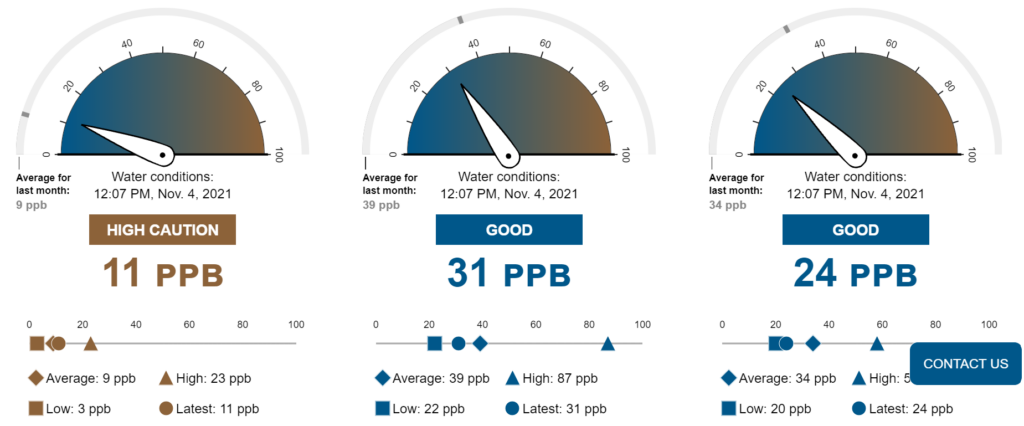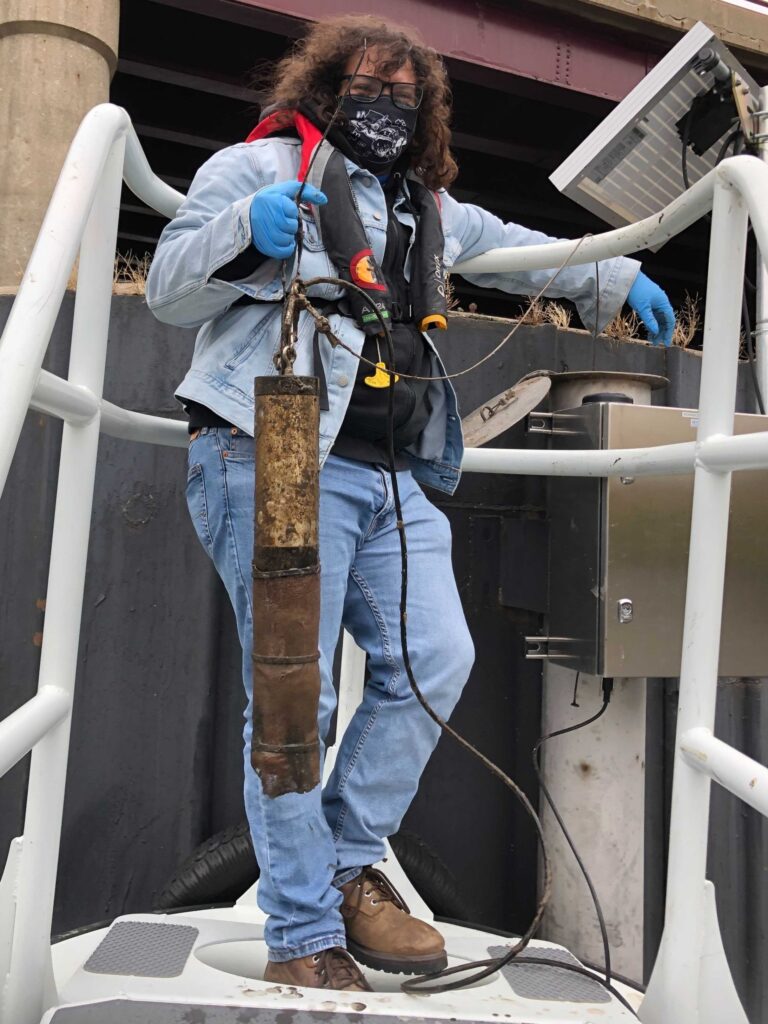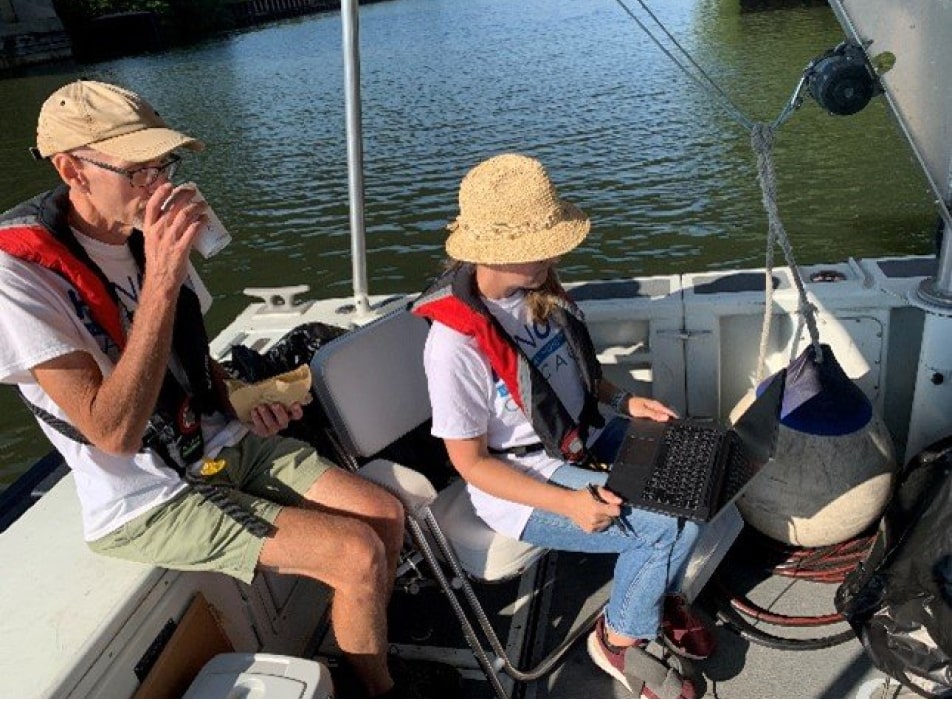H2NOW Chicago 2021 Season Recap: What We Learned, What’s Next!
On September 2, 2021, Current and our partners officially launched H2NOW Chicago to provide real-time water quality data for the Chicago River to the public. Now, as winter approaches and the river’s recreational season comes to a close, it is time to take the Proteus probes out of the river until early 2022.
The probes have been installed in the Main Stem, South Branch, and North Branch of the River for nearly seven months, gathering and transmitting data about water quality conditions. Each probe is equipped with several sensors that measure tryptophan-like fluorescence (TLF, tryptophan), turbidity, temperature and depth. Tryptophan readings (compensated for temperature) are taken to evaluate microbial water quality and estimate the level of fecal coliforms present in the water, while turbidity, depth, and temperature allow us to understand more basic characteristics of the river: how murky the water is, and how water level and temperature change over time.
Weather, and especially precipitation patterns, have a significant impact on water quality in the river. Our 2021 season, with its intense storms and long stretches of drought conditions gave us plenty of opportunities to see what happens to our river during different types of rain events and dry weather periods. Here’s how our changing weather shows up in H2NOW data:
During particularly strong and lengthy storms, a combined sewer overflow (CSO) may occur, which results in stormwater and untreated sewage flowing into the river. There were 12 CSOs reported this summer and fall in the Chicago River. CSOs have so far had significant impact on the Proteus probe readings, as seen in the tryptophan spikes on October 26 in the figure below:

What have we learned from H2NOW so far?
Since the Labor Day weekend launch, H2NOW Chicago has been visited more than 12,000 times and our team has received many questions from curious site visitors, both here in our region and across the country! We’ll be adding answers to some of the most common to our FAQ page over time.
One of the biggest and most important questions concerns the gauges, and the displays showing different tryptophan numbers at each branch. How is it possible for the level to be higher on the North Branch (middle gauge) and the water quality reading be “Good”, and the level on the Main Stem (left gauge) be lower with a gauge reading of “High Caution”?

We recognize that this can be confusing! Measuring TLF to estimate fecal coliform levels is still a very novel area of science. Part of what Current is testing with H2NOW is this new sensor’s capabilities, and how well TLF correlates with real fecal coliform levels as confirmed by conventional grab samples and lab tests. Scientists still don’t fully understand all of the variables that affect TLF readings, but we do know that the water in each branch of the Chicago River comes from different sources and has different background levels of TLF.
To get a clearer picture of how TLF levels relate to microbial concentrations, our team conducts fecal coliform tests at each branch and compares them to the sensor readings. In this way, we are learning how TLF levels affect microbial water quality, and are able to come up with conservative estimates of the water quality readings for each branch that vary accordingly. As we gather more data with each new season, we will continue to improve our correlation models and our assessment of how well this novel technology helps us understand important information about our River’s health.
The values on the gauges are designed to be useful to the average visitor to the site, looking for guidance on how to safely interact with a particular branch of the River on a given day – like a weather report. The gauges are a simplification, and they don’t share the whole story. For those who want to dive deeper into the data, we include the full data plots, and soon will be able to provide fully downloadable open data to the community.
What is going to happen now?
With winter around the corner, we’re preparing our probes for hibernation and beginning to plan for the 2022 recreational season. The probes came out of the Chicago River on November 8, 2021 with a big assist from our partners at MWRD.

We’ll perform maintenance on the sensors and calibrate them to ensure data accuracy, and engage our research partners from Northwestern University and elsewhere to analyze 2021 data from the probes, MWRD, the U.S. Geological Survey (USGS), and local weather reading to help us develop a better water quality assessment for 2022. These multiple data sources help us understand how our tryptophan readings correspond to other parameters, weather events, increased flows, and lake water intrusion. This data analysis will also help us determine whether or not we need to include other sensors to improve our fecal coliform readings, the most important parameter we need to measure.
In addition to data analysis, Current will be working on case studies for all the technologies we have piloted this year, including the Proteus probes, TECTA B4, Wavelet from AYYEKA, and iGreen from IOSight. Read more about the main technologies used for H2NOW here. Watch this space to find out what we’re learning!
What does the next phase of H2NOW look like?
We are planning to reinstall the Proteus probes in the river by the end of March or early April 2022. After a series of field tests to confirm that the platform is calibrated, we will relaunch the gauges on our H2NOW online platform. The team will collect samples and more fecal coliform data throughout the summer so we can periodically update our assessment. If the public health guidelines for COVID-19 permit it, we are hoping to enlist volunteers to help with our sampling efforts. Please get in touch with George Brigandi (gbrigandi@currentwater.org) if you are interested in participating. We will also continue to build on the recent launch of our River Lab curriculum and virtual Chicago River field trip for high school students, and hope to have opportunities to extend the learning from the classroom and zoom room to the River in 2022!

Thanks for your interest and support as we continue to refine this first-of-its-kind platform for real-time water quality monitoring! Bringing novel technologies into the real world takes collaboration and creativity, and we could not have achieved the 2021 launch without support from you, our partners and the vast community of Chicago River lovers, stewards, and users. Stay tuned for more updates about H2NOW, and as always, please get in touch with us if you have ideas for future collaboration. We love to hear from you!




